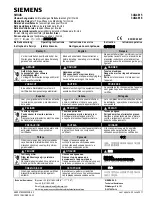
107
2.1
Trip class / tripping time (IEC 947-4-1). Relays C, GL, P, PF, G and GEN
The different trip classes / tripping times enable the user to select the overload protection according to the various motor applications in either short or long
start-ups and for different generator uses.
The class number or the tripping time refers to the maximum approximate time in seconds allowed for the direct start of the motor from a cold condition.
To select the trip class or tripping time (t
6 x
,
B
) use the corresponding dip switches. The recommended values are listed in the following tables.
Average trip curves (IEC 947-4-1)
Cold curve:
represents
the performance of the
relay without any previous
current flow, first start.
Warm curve:
the tripping
times decrease as the
current flows, and is
adapted to the motor
heating condition based
on the thermal memory.
The warm condition (IEC-
255) is reached after a
current of 0.9 x
,
N
(motor
rated current) flows during
approximately 2 hours.
Motor with star-delta start
Motor with direct start-up
C
P
PF
GEN
GL
PS
G
Start
time (s)
Trip
time
Trip classes
Models
Model
Trip classes
Start
time (s)
Trip
time
Models
Model
Generator’s limit curve

























